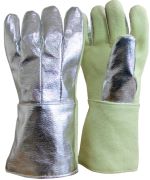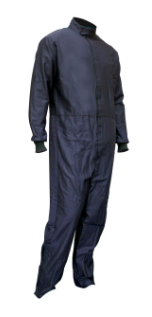Personal Protection Requirements in High Heat Environments
Working in high-heat environments requires proper selection and use of personal protective equipment. The choice of PPE is based on the type, frequency, and duration of exposure to an identified hazard that is revealed in an organization’s risk assessment.
Exposures result in injuries
Numerous hazards involve physical, chemical, and thermal exposures, each requiring PPE that exceeds “general duty” protection levels. For example, general duty gloves won’t protect hands from puncture or laceration hazards or when handling chemicals. General duty uniform shirts and trousers don’t protect the wearer from thermal, high-heat, or arc-flash exposures.
Thermal exposures to heated liquids and hot surfaces can result in serious second and third degree burns. Health hazards are also a concern as both working in a high-heat environment and the PPE worn to protect from high-heat risks can create the potential for heat stress.
Injuries result in costs
Exposures to hazards and the resulting costs of injury are great. The cost to the employee and his/her change in quality of life resulting from the injury includes pain, additional financial stressors to the family, disruption of normal routines, and ongoing rehab or extended recovery times. The cost to the employer is also financial and impacts production, schedules, customer concerns for not meeting deadlines, and overall reputation in the community.
Specific to high-heat environments, there are two levels of PPE needed to properly protect employees from risks identified in the assessment.
Primary Heat PPE
Primary Protective Clothing is designed for work activities in which a specific task exposes an employee to molten substance splash, radiant heat, and flame. Examples of work activities may include charging, taping, and pouring, when performing tasks near or with molten substances and hot surfaces, and for which direct contact is likely.
Primary Heat PPE Examples
- Aluminized apparel, such as aprons, pants, coats, hoods, sleeves, spats
- High-heat-resistant gloves and mittens
- High-heat-resistant face shields
Secondary Heat PPE
Secondary Protective Clothing is designed for continuous wear while performing activities in which intermittent exposure to molten substance splash, radiant heat, and flame sources is possible. Secondary protective clothing is fabricated to reduce combustion after exposure to and removal of a source of ignition. Secondary PPE is also appropriate when tasks cause employees to be at risk for an incipient metal splash and radiant heat, whether from welding or proximity to extremely hot metal surfaces.
Secondary Heat PPE Examples
- Fire-retardant (FR) “greens” fabric or treated cotton material in jackets, pants, shirts, sleeves, hoods
- Nomex® jackets, pants, shirts
- Arc-flash uniform shirts, pants
- Welding apparel, such as FR beanies, jackets, aprons
Intermittent Heat PPE Examples
These items are not necessarily worn continuously, but are provided for specific tasks in which there is potential exposure to flame, radiant heat, or hot surfaces at a lower risk level:
- Welding or high-heat-resistant gloves
- FR Leggings, spats, baklavas,
- FR-treated cotton hoods with lens/window
- FR cotton or Nomex® Spark deflectors
Solutions
It’s important to identify the proper level of protection needed, based on the work environment and assigned task. Taking a position that “more is better” rather than matching the PPE to the hazard can add heat stress risks to employees and impede their ability to complete tasks efficiently and productively. Selecting the wrong level of PPE for the environment or task or choosing to ignore specific hazards places employees and the employer at significant physical and legal risk.
What can an employer do? Chicago Protective Apparel (CPA), a division of Mechanix Wear, offers a full service and line of protective apparel that will help employers ensure their employees are properly protected while productive.
As a service, CPA offers employers its TRACK program, providing employers with expertise in conducting effective risk assessments, matching the right PPE to the identified hazards, and including a no-obligation trial with front-line employees on all recommended PPE. There is no purchase required until the employer is satisfied that the PPE works. The fact that front-line employees wear the PPE before purchasing allows them a say in the selection and buy-in for wearing it after purchase.
In addition to TRACK, CPA offers a full line of high-heat protective clothing and gloves. Unsure about what to purchase? CPA PPE experts will ensure you obtain the right PPE for the identified risks.
There is never a reason for employees to be at risk or to have purchased ineffective or improper PPE for those risks when Chicago Protective Apparel provides full service and PPE that protects employees and keeps them healthy and productive. Whether the need is for primary or secondary levels of protection, CPA has you and your employees covered!

